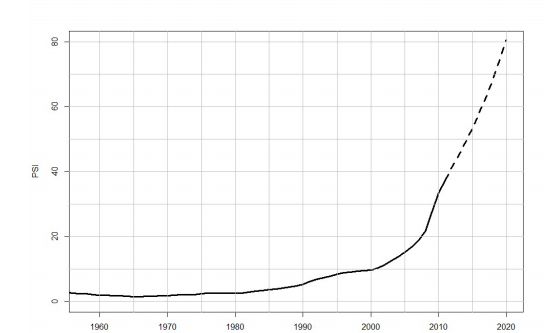
Date: March 10, 2019
Author: Paul Cockshott
1 Capitalism
Class society
The most important thing about capitalism is that it is a class system. It is a society based on class hierarchy dominated by a rich upper class. Like any class system it is unequal. Like any class system it is based on exploitation, on majority working to benefit a minority. Exploitation and inequality gel together to form classes when they become inherited down through the generations. If the rich pass on their wealth to children, if the children of the rich have special access to the best education and positions of authority then you have a class society.
Previous class systems were open and unashamed. Men of noble families boasted of lineages stretching back to Charlemagne. Even a hundred years ago aristocratic pride did not hide. Now class is more discrete, but no less real. The stability of social class is shown in the way that the same families continued to dominate among the surnames of students enrolled at Oxford and Cambridge Universities from the middle ages (Fig 1). If you take Norman names like Darcy, Mandeville, Montgomery, Neville, Percy, the ruling class of the early middle ages, these have persisted among the elite right down to the present.
We of course know that feudal society was hierarchical, but capitalism and liberalism were supposed to have brought democracy and social mobility. But no, researchers find that:

Figure 1: Elite medieval rare surnames (sourced from the Domesday book (Norman), Inquisition Post Mortem (IPM) and those of Locative origin) rate of decline in representation at Oxbridge, from [2]. This shows that families who were part of the elite in the 12th century are still over represented at the top universities in England. Social mobility does not increase with the emergence after the Industrial Revolution of modern social institutions, such as public education, mass democracy, and redistributive taxation. [2, page 7]
By looking at the rate of decline in frequency of elite family names in Oxbridge sociologists can show that the inter generational persistence of elite status in capitalist and feudal society are the same ( Figures 1 and 2). The upper levels of the ruling class have had a 93% chance of passing on their elite status for centuries, the middle levels of the elite an 80% chance. This elite persistence continued despite industrialisation, despite growth in population, despite the low fertility of upper class families. This class persistence is not just a English thing. A Bank of Italy study has shown that the same families who were wealthy in 15th century Florence are better off now[1].

Figure 2: The rate of decline in elite status for the capitalist period is the same as for the feudal period shown in Figure 1. The rate of decline is given by the slope of the lines giving the relative over representation of given surnames at Oxbridge compared to the general population. Taken from [2].
In the middle ages exploitation of the peasantry by the barons was naked and brutal. Serfs had to work on the land of their masters without pay and were bound to the land. This exploitation is measurable using the next two tables.
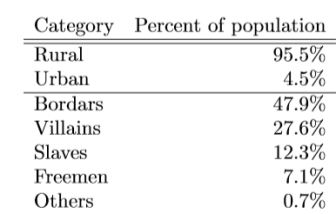

You can measure it in terms of a rate of exploitation, or a labour share. The rate of exploitation is the ratio of the output going to the exploiting classes versus the output going to the producers. In the England of the 11th century we can see that about 17% of the population was supported out of the surplus produced by the peasantry. So the labour share of the peasants in the farm economy was 83%, this is an exploitation rate of 21%.
Now look at Figure 3, which gives the development of the labour share in US capitalism. You can see two important points. Firstly the long term trend is downwards. Workers get a decreased share of what they produce. Each peak of prosperity is at a lower level, and each is followed by a recession in which the worker’s share is further diminished.
Secondly, even at the best years of the 1950s, the worker’s share peaked at 66%, well below the level in early Feudal England. In more recent years workers share fell to 56%. That is an exploitation rate of 78% almost four times as bad as in 1086.

Figure 3: Decline in the labour share of value added in the USA, Bureau of Labour Statistics, USA.

Figure 4: The rise in inequality USA. From World Inequality Database https://wid.world/country/usa/ Red line share in national income of the bottom half of the US population, blue line the share of the top 1%.
Exploitation is the ultimate source of inequality. As the rate of exploitation rises, class inequalities intensify. An ever greater share of national income flows to the top 1% and the lower half of society gets poorer. In the US the top 1% get 20% of all income the bottom 50% get 12.5%. So someone in the top 1% is, on average, 80 times better off than someone in the bottom half of the population.
Even figures like the above fail to account for the full degree of exploitation. Having been paid a fraction of the wealth that they create, workers are then exploited a second and third time round. First they have to pay between a 1/4 and a 1/2 of their wages to a landlord: In 2016, median monthly private rent for England was 27% of median gross monthly salary. This means that someone working in England could expect to spend 27% of their monthly salary on private rent. London, the South East, East of England and the South West, all had percentages above this level. Overall, median monthly private rent as a percentage of median monthly salary ranged from 23% in the North East, to 49% in London. (Housing summary measures analysis: 2016, Office of National Statistics)
Next the banks take their share. The average debt per household in the UK is more than £57,000. Of this about £10,000 per household is unsecured debt on credit cards and consumer purchases. Because of the high rate of interest on these loans the average person pays 3.5% of their income in interest payments alone.
Then come taxes. Part of that pays for what can be termed a social wage, but another large part goes to defend the rich, or direct into their pockets. In the USA 54% of all discretionary Federal spending goes to the Pentagon roughly another 7% goes as interest on the national debt.
Population destruction
It is no surprise that capitalism, having driven half the population to poverty and despair, finds that it is ultimately unable to reproduce the workers on whom it depends.
The USA, and now the UK are already showing declines in life expectancy. Deaths due to poisoning, suicide, liver disease – the afflictions of poverty and despair take an increasing toll ( Figure 5).
A large part, the poisoning line in Figure 5, is caused by the deliberate promotion of opiate addiction. From the East India Company pushing Opium to the Chinese in the 1840s, the Bayer company selling over the counter Heroin as a ‘cure’ for morphine in 1895 to Purdue Pharmacy aggressively launching Oxycontin in 1995, companies have seen addicts as a secure source of income. The ‘legitimate’ drug firms open the doors to addiction, which is then further exploited by the black capitalism of the illegal drugs rings. The profits are then laundered via blue chip banks like HSBC in the City of London, a bank that was founded from the profits of the Opium trade to China.

Figure 5a: The rise in mortality due to the diseases of despair, USA. Poisonings are largely drug overdoses, chronic liver disease largely the effect of alcohol.
The most dramatic example of the pathological effects of capitalism on population come from the former socialist countries. The transition to capitalism led to a precipitate population decline ( Figure 5b ).9 Comments Paul Cockshott The most dramatic example of the pathological effects of capitalism on population come from the former socialist countries. The transition to capitalism led to a precipitate population decline ( Figure 5b ).

Figure 5b. The whole socialist area of Europe experienced steady population growth until the transition to capitalism, after which population declined sharply. Calculated from the UN World Population Spreadsheet 2015 edition.

Figure 5c: Evolution of Russian birth and death rates in Soviet and post-Glasnost periods. Bezier plot.Shaded area post-Glasnost. Source [15] and UN Demographic Yearbooks Table : Excess deaths consequent the introduction of capitalism in Russia amount to some 12 million over 20 years. Data from successive UN Demographic Yearbooks, table 18.
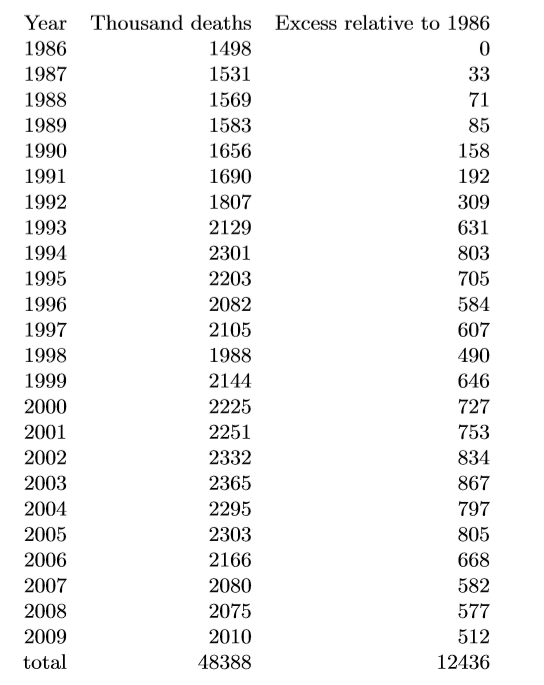
Along with rising death rates you can see in the former USSR a collapse in the birth rate so that more people die than are born to replace them. As wage shares decline, it becomes impossible for families to survive on one income. The pressure to work more, the pressure to acquire qualifications for work, the shortage of affordable family houses, the lack of affordable childcare causes women to delay or abandon having children.
More and more people stay single and give up the hope of having a family. The effect was most dramatic where capitalism was suddenly imposed but the pattern of births falling below deaths spreads across the capitalist world. The effect has gone furthest in Japan where for 2017, 946,000 babies were born but 1.34 million people died, with the decline of the population reaching 394,000 in a single year. In 2018 it looks as if the shortfall in births to deaths will be more like half a million people. As Figure 6 shows this trend of a failure of capitalist societies to reproduce their populations is spreading.
A similar inability to reproduce the population has heralded the doom of past class societies. The Roman Empire, built on slavery, faced the same problem.

Figure 6: The graphs show the actual and projected rates of natural population change measured per 1000 per year. Thus a figure of -4 means that the population is shrinking by 0.4% a year. Plotted from the UN population database.
The early urban capitalism of the High Middle Ages in Europe was likewise a consumer of peoples. The disease ridden and insanitary cities within which nascent capitalist economies existed, could only maintain themselves by a constant influx from the countryside.
Once exploitation by the elites becomes insupportable, once a society can no longer maintain its population, it goes into crisis. The forms assumed by the crisis differ. Capitalism’s fall will not recapitulate that of Rome or the great European crisis of the 14th century[12, chap 4.4]. But we can see its economic effects already working themselves out.
The rate of return on capital is set by the relationship between the total property income ( economic surplus ) and the total capital stock. Corresponding to a given monetary flow of profit there is a population of millions of people whose output goes on the commodities purchased out of profits. Since money is a variable standard of value, we can express the profit rate in real terms as the ratio:
| number of people working to produce the economic surplus |
| number of person years embodied in the capital stock |
If the capital stock rises faster than the number of people producing the surplus then the rate of profit must fall. Therefore rapid accumulation of capital compared to the growth of the working population tends to depress the rate of profit. If the population stops growing or shrinks, then there is no longer any positive rate of profit compatible with capital accumulation. This process makes itself felt first in that country which traditionally had high investment rates and in which the population slowdown was most marked: Japan (Figure 7).

Figure 7: The decline in the real rate of profit ( dashed line ) in Japan. The solid like is the Marxian equilibrium profit rate for an econmy with the actual Japanese rate of growth of the workforce and actual rate of accumulation. As you can see the real rate follows the marxian equilibrium rate with a lag. For the derivation of this see
Technological conservatism
De te fabula natur. What started in Japan spreads.
A stagnant labour force means low profit rates and low profit chokes off accumulation. The ruling classes attempt to offset the pathology of their societies by importing labour. They succeed in delaying the expected consequences of a tight labour market: a rising labour share. But cheap labour brings its own economic consequences. If labour is cheap and accumulation expensive, it is not worth investing lots in labour saving machinery. So across the capitalist world stagnant accumulation and rising exploitation goes hand in hand with technical conservatism. This results in a general slowdown of growth to no more than the rate of population growth (Figure 9). Perhaps nowhere can this be more dramatically seen than in the UK (Figure 8) whose recent growth model has been entirely based on the importation of cheap labour. This decline in technological vigour is occuring just before a major environmental crisis, whose effect is bound to be to substantially increase the real labour costs of many products.
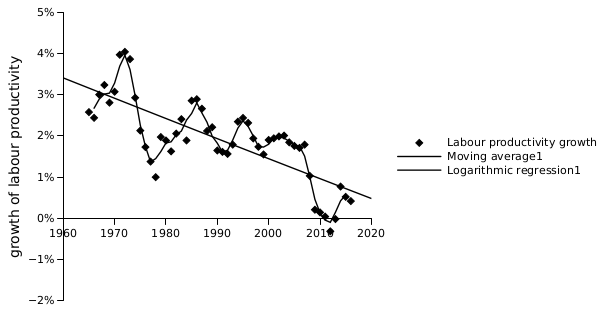
Figure 8: As exploitation rates have increased in the UK it becomes less and less economic for capitalists to invest in new labour saving machinery. Instead growth depends on using more labour more cheaply and inefficiently. Data from [8].
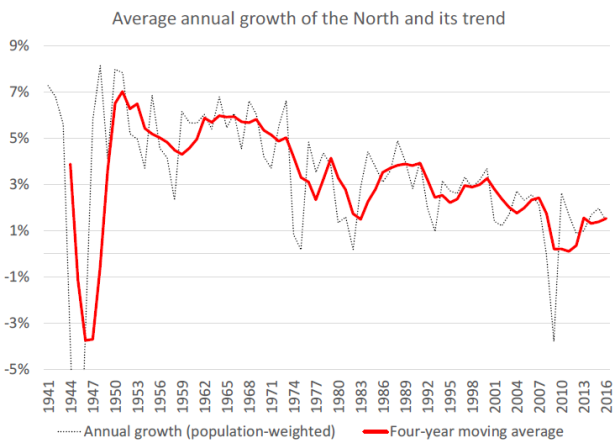
Figure 9: Population-weighted average of annual percentage growth of principal industrialised countries, local currency units, [4].
In the past, major transitions between forms of economy have been associated with the exhaustion of the resources upon which former societies relied. Mesolithic extinction of the megafauna may well have been what forced the neo-lithic transition to farming. Exhaustion of the reserves of forest wood for iron making by the 18th century, forced the shift to coal, coal demanded steam engines to pump the mines, and steam engines drove industrial capitalism.
The use of fossil fuels will draw to a close either due to the depletion of oil reserves, or due to international action to ban their use. On present trends, and if the IPCC climate models are right, that will not occur before significant climatic changes have been set in train. Areas of the world will, by late 21st century be experiencing heat stress on staple food crops:are likely to include Global hot spots of crop heat stress overlap with important agricultural regions such as Eastern China, the Northern United States, South-Western Russian Federation and Southern Canada . This indicates that agricultural production in temperate countries may suffer substantial production losses from climate change
The worst affected crop could be maize which uses C 4 photosynthesis, and unlike C 3 photosynthesis crops like wheat and soy do not benefit from CO 2 fertilisation as atmospheric concentrations rise[3]. In consequence food yields will fall, and food prices rise significantly but with different crops affected to a different degree. The food shortages may be of catastrophic dimensions in areas currently heavily dependent on maize unless shifts to other crops can be effected. In more extreme scenarios, with global temperature rises of the order of 10 ○ substantial areas become not only too hot for crops, but lethal for humans[10]. Under this scenario, the larger part of the current human population could not survive. Before this point is reached the efficiency of human labour will fall substantially, with many days being too hot to do productive work[7].

Figure 10: The wet bulb temperature distributions are roughly what would be expected with 10 °C of global-mean warming relative to the last decade. Areas where the wet bulb temperature rises above 35 centigrade for several days in the year are essentially not inhabitable by humans or other large mammals. Note that this includes areas that currently have high populations in India, China, Africa and North America. Reproduced from [10].
It remains, I suppose, possible that the IPCC climate models are wrong, and that surface temperatures are somewhat less sensitive to greenhouse gas concentrations than the models assume [5, 9, 6]. Even were we make the optimistic assumption that the climate is less sensitive to greenhouse gas forcing than the dire scenarios above, the exponential growth of oil use coupled with the passage of peak oil have drastic implications for several technologies upon which capitalist civilisation has depended:
- Steel Steel is the fundamental structural material of capitalist civilisation, but steel production releases large quantities of carbon dioxide. Until and unless direct hydrogen reduction of iron ore becomes technically viable, steel availability will be limited to recycled scrap smelted in electric furnaces. This has big impacts on the long term price of all things built out of steel : vehicles, ships, bridges, buildings etc. Aluminium can be used as a partial substitute but it is substantially more expensive, and inferior for many purposes.
- Concrete The urbanisation that has occured since the mid 20th century has relied on concrete, but concrete production also releases large quantities of CO 2 , so its use will be greatly resticted. Brick the obvious substitute also involves the burning of coal. Stone, the construction material of much 19th century capitalism would be viable, but it increases building costs a lot.
- Shipping The great engines of capitalist globalisations have been the marine triple expansion engine in the late 19th century and the heavy marine diesel since the mid 20th century[11]. Both rely on fossil fuel. A post fossil fuel era must either revert to sailing ships, use nuclear freighters or perhaps liquid amonia as a fuel for gas turbines.
2 Socialism
Technical progress and Environmental planning
In the previous section we argued that capitalism has been slowing down in its ability to generate technical progress, just at the point when environmental constraints are about to make ‘business as usual’ inadequate. To shift to an economy that no longer uses fossil fuel is going to require capital investment on a massive scale that, on present evidence, capitalist economies are unable to undertake. Over time the level of net capital investment in real productive resources has declined as a share of GNP, whilst luxury consumption, and unproductive speculative financial sectors have consumed a growing share of economic surplus.
The response of the capitalist states to environmental has been to attempt to use market mechanisms and market incentives to bring about change. Take for example the French Republic. The government of President Macron adopted classic liberal measures: taxing diesel fuel whilst abolishing wealth taxation. Supposedly this would incentiveise people to switch to electric cars, whilst the super rich, freed from taxation would finance the necessary investment. In effect it was using environmentalism to cloak an otherwise naked shift in wealth from the poor to the rich.
Think about it. Carbon dioxide use can not be shrunk any faster than new electric trams, trolly buses, and battery cars are built to replace existing diesel ones. A socialist approach would be to set physical targets for the number of new internal combustion vehicles, phasing out new diesel production over perhaps two years. At the same time the state would order electric buses, trams, whilst building the rail freight infrastructure to completely phase out long distance lorry traffic. Long distance freight would be shifted on container trains to local depots where they could be delivered by short range electric lorries.
But all this is incompatible with a fragmented system of private road haulage companies.
France has at least, a good base of nuclear power plants. But even there, the shift of inland transport to electricity will be impossible to achieve without many more power stations. Other European countries are far behind. 30 years of privatisation of electricity in the UK has destroyed its native ability to design and build nuclear plant. It has become entirely reliant on the state owned French and Chinese power industries to construct such nuclear power as it is building. The attempt at a privately financed nuclear power station in North Wales collapsed just the other week. But we know that when the state owned the power system and took the lead both France and the UK were able to engage in a crash programme of nuclear power development after the 1956 oil crisis. They did this from scratch, at a time when nuclear power stations had never yet been built. Yet by 1970 they had installed tens of stations.
The required level of infrastructure investment in nuclear, wind power, new rail and tram lines is going to be huge and the only the only historically comparable mobilisations have been the planned development of the Soviet and Chinese state led economies, or perhaps the redirection of US industry, under state orders, to war production after 1941.
Entire new metal fabrication infrastructures will be needed : greatly expanded aluminium production, a conversion, if technically feasible of steel production to use ionised hydrogen rather than coke in the reduction of iron ore. Again the only comparable examples are the crash development of the Soviet steel industry.
The world’s shipping fleet will have to be entirely rebuilt. Oil fired ships will have to be replaced either with modern designs of sailing ship or liquid amonia gas turbine vessels. Again this means a huge demand for labour and resources in the shipbuilding industry.
In societies with declining labour reserves how can this be achieved?
It can only be done by moving to a new set of economic relations, socialist ones, that prioritise real labour saving innovation rather than cost saving.
The great failing of capitalist rationality is that, because it is done in terms of money, it can not distinguish between real economic progress and brutal exploitation.
It makes no difference to Ford if it reduces costs by actually using 25% less labour to produce a truck, or whether it just shifts the factory to a country where wages are 25% lower. Their aim is to minimise wage costs, not minimise human effort.
But if all firms were worker owned, run as mutuals or cooperatives, then the option of reducing costs by paying themselves less, simply does not arise. If a cooperative is to improve its performance, it can only do so by the use of real innovations in the use of human effort, or by economy of energy and raw materials.
Transforming the whole economy into a system of cooperatives is the first step in moving from a monetary economy to one based on a rational use of labour.
The first legislative act of a socialist government should be the outlawing of exploitation, and Act which decrees that all value added in a firm is the collective property of the employees of the firm, and that the directors of a firm must be elected by it’s employees.
Such an approach has great advantages over the traditional approach of Social Democracy which has been to take firms into public ownership:
- Since the Act outlaws exploitation, there is no question of former owners being compensated. From that point hence appropriation of profit becomes a criminal act, and one does not compensate criminals.
- It leaves the existing and functioning organisational structure intact. The firms continue trading, but the beneficiaries of that activity change.
At this stage one would still have a market economy, albeit one free from exploitation. To move towards a fully socialist system two linked stages have to be traversed:
establishing in democratic planning and replacing money with labour time accounting.
So long as you have cooperatives trading you still have monetary relations between them. You can only replace money with time as a unit of account once the collectives are working for a directly social purpose rather than their own particular interests.
In a static economy that transition might be difficult to achieve, but in the context of massive restructuring to meet environmental challenge it is a different matter. The worker owned firms would have to be restructuring their production processes to minimise fossil fuel use and generally reduce the environmental footprint:social rather than private imperatives. As such the additional investment will have to be met out of general taxation. With public grants towards new plant and equipment would go the obligation to use such indirect labour in the public interest. Step by step, perhaps via worker’s syndicates, the industrial system would be brought into a comprehensive plan. Modern computer and communications technology will allow this to be done far more accurately and far more responsively than was possible in 20th century socialism, dependent as it was on human bureaucratic calculation.
Equality/classlessness
With the installation of directly social production, money as such can be phased out. Banknotes and coin will disappear, as will all private monetary transfers. The infrastructure of smart cards and readers will be repurposed to work with labour credits. With the very first step, abolition of exploitation, non labour incomes disappeared When money payments are replaced by time credits, that other great source of inequality, the different valuation of male and female time also vanishes. People would be credited with hours worked rather than money at the end of the week. Payments for goods and services would also be in terms of time. You would pay for a garment that took two hours to produce with two hours of your own time.
There is more to eliminating classes than just getting rid of property income. As I said at the begining, class persists for centuries. Access to wealth, connections and education means that some families remain at the top generation after generation. Get rid of property incomes and you take a big first step. But there would still remain ingrained prejudice that certain jobs were ‘worth more’ than others, and that people with professional qualifications deserve more. This would be the foundation for class differences surviving even in a socialist society. Getting rid of money helps.
An economy based upon time-prices would have built into it the democratic presumption of human equality.
It is much harder to justify paying a graduate more than a time served worker if things are expressed in time not money. Monetary inequalities are self justifying. The very fact that a doctor is paid more than a cleaner seems to imply that she is worth it. With time the mystification is stripped off. Each has a finite life, one hour of a cleaner is as much a deduction from her life as that of her sister the doctor. If the time the doctor spent in training was paid for by society, with student grants and free education, that no longer counts as a justification for higher pay.
But to remove the cross generational effects, whereby the daughters of doctors become doctors and daughters of cleaners, cleaners, you need more.
Beyond free education, it is necessary to give every school child the firm belief that all avenues are open. That there is no longer a class barrier to education. University admission systems, whereby elite colleges recruit from the elite, have to go. A common college entrance exam accross all colleges, with blinded random allocation of those passing the exam to different universities would be needed to break down the elite inheritance of places like Oxford (Figure 1).
Population
When the national budget is cast in time rather than money, it becomes at once possible to ensure full employment, and to be aware that it is our numbers and our time that constitutes the real constraint on what can be done. Public health and the preservation of life become central. Socialist countries like Cuba, Vietnam and China have achieved dramatic extensions of life expectancy (Fig. 11).

Figure 11: Life expectancy in India, China, Russia and Vietnam. Drawn using data from World Bank database.
Meanwhile America is following Russia down the path of declining life expectancy, and sub-reproduction fertility. I mentioned above that opiate and alcohol addiction has become the leading cause of death in the US (Fig. 5). A great strenght of a planned non monetary economy is that it cracks down on these diseases of dispair from two directions: full employment and secure incomes remove one major cause whilst without money, the black market in drugs vanishes. Conversely, one of the first effects of the former USSR moving to a convertible currency was that the illegal drugs trade took off.
There is still, even in progressive circles, a widespread worry about over population. For a country like Red China in the 1970s this was well founded. A nation whose arable land was already used up, whose life expectancy was soaring, really did need to plan its population if it was to avoid hunger. But for the developed capitalist world the reverse is the case. They have birth rates so low that they are threatened with population collapse in the next couple of generations.
A socialist system, where wealth goes to those who produce it, will allow the shorter working weeks that both mothers and fathers need if they are to feel confident about bringing a new generation into the world. The capitalist world penalises and scapegoats young single mothers, condemning them to a life of povery. In striking contrast, the 20th socialist countries removed the stigma, provided financial support, housing and free childcare. One only has to compare the birth rates in East and West Germanies in the latter 20th century to see the effect.

Figure 12 German total fertility in children per woman. Drawn using data from German Federal Statistical Office. 21st Century socialism will build on this experience and do even better.
References
1Barone, Guglielmo and Mocetti, Sauro, “Intergenerational mobility in the very long run: Florence 1427-2011“, (2016).
2Clark, Gregory and Cummins, Neil, “Surnames and social mobility in England, 1170–2012“, Human Nature 25, 4 (2014), pp. 517–537.
3Deryng, Delphine and Conway, Declan and Ramankutty, Navin and Price, Jeff and Warren, Rachel, “Global crop yield response to extreme heat stress under multiple climate change futures“, Environmental Research Letters 9, 3 (2014), pp. 034011.
4Aln Freeman, “The sixty-year downward trend of economic growth in the industrialised countries of the world.“, Manitoba: Geopolitical Economy Research Group (2019).
5Harde, Hermann, “Radiation transfer calculations and assessment of global warming by CO2“, International Journal of Atmospheric Sciences 2017 (2017).
6Holmes, Robert Ian, “Thermal Enhancement on Planetary Bodies and the Relevance of the Molar Mass Version of the Ideal Gas Law to the Null Hypothesis…“, Earth 7, 3 (2018), pp. 107–123.
7Kjellstrom, Tord and Briggs, David and Freyberg, Chris and Lemke, Bruno and Otto, Matthias and Hyatt, Olivia, “Heat, human performance, and occupational health: a key issue for the assessment of global climate change impacts“, Annual review of public health 37 (2016), pp. 97–112.
8Marquetti, Adalmir and Foley, Duncan, “Extended Penn world tables: economic growth data on 118 countries“, New York, New School University,(h ttp://homepage. newschool. edu/˖͂ foleyd/epwt/) (2002).
9Nikolov, Ned and Zeller, Karl, “New insights on the physical nature of the atmospheric greenhouse effect deduced from an empirical planetary temperature model“, Environment Pollution and Climate Change 1, 2 (2017), pp. 112.
10Sherwood, Steven C and Huber, Matthew, “An adaptability limit to climate change due to heat stress“, Proceedings of the National Academy of Sciences 107, 21 (2010), pp. 9552–9555.
11Smil, Vaclav, Two prime movers of globalization: the history and impact of diesel engines and gas turbines (Mit Press, 2010).
12Turchin, Peter and Nefedov, Sergey A, Secular cycles (Princeton University Press, 2009).
